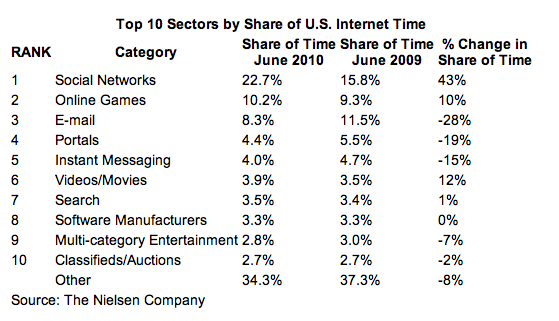You can’t afford to ignore social networking sites
It’s important to establish yourself now on social networking sites. First, users are spending increasingly more of their time on social networks, even when they’re on the go. Second, you need inbound links to improve your page rank. Third, you need to attract new audiences.
“Despite the almost unlimited nature of what you can do on the web, 40 percent of U.S. online time is spent on just three activities – social networking, playing games and emailing, leaving a whole lot of other sectors fighting for a declining share of the online pie,” said Nielsen analyst Dave Martin.
Time flies when you’re having fun
According to a new poll released by the Neilson Company, Americans spend almost 23 percent their time online on social networking sites, up from 15.8 percent last year (a 43 percent increase). This is almost triple the amount of time spent on email activities. In a Nielsen survey of mobile web users, there was also a double-digit (28 percent) rise in the prevalence of social networking behavior.
With these statistics in mind, take a look at the well established brand American Quarter Horse Association. They are a great example of using social networks to the fullest to increase website traffic. AQHA uses Facebook and Twitter to connect with users, to link to their AmericasHorseDaily blogs and promote interest in their online store and print publications. They also upload video on their own YouTube channel. All of this contributes to a strong web presence and improves branding – which leads to increased website traffic.
[text_ad]
What’s the real value of those inbound links?
Basically, it’s like a popularity contest. The more links you have, Google believes the more popular you are and rewards you with a higher page rank. How do you get more links? That takes us right back to social networking.
For every piece of content you create, for every product or service you offer there should be comments posted on Facebook, tweets on Twitter, links on LinkedIn, email newsletters sent to subscribers, press releases being submitted, etc, etc, etc.
Google likes to see that you play well with others. Do you link to other blogs and sites? If not, how can you expect others to link to yours?
Here today…gone tomorrow
Ok, maybe I’m being dramatic, but let’s face it – online users can be finicky. Today they need you, they love you, your website and all that it stands for. Tomorrow their needs change and they unsubscribe.
Disappointing? Yes! Unexpected? No, but you do need to replace them or you’ll be out of business fast.
Yet another good reason to use social media is to attract new audiences. Some users may not have stumbled upon your site if it weren’t for a tweet that caught their eye or if a friend hadn’t “liked” your page on Facebook.
At Mequoda, most Fridays are Free Report Friday. We promote it first to our email subscribers and then in our Twitter feed. Not surprising, a good majority of our new email sign-ups come from these Friday tweets that introduce our followers to a new white paper on our website.
All of this together contributes to increasing website traffic. In turn, that increases the number of email subscribers, ultimately allowing you to improve your email conversion rate. And isn’t that what it’s all about?




People’s likes change every day. I’ll subscribe to an email newsletter one day because I want to hear from the company about upcoming products, events, etc. but if they don’t continue to impress me, I’ll eventually unubscribe.
On that note, I subscribe to the Twitter feeds of email newsletters that I unsubscribe from, if I still think their content is good, but I don’t want to be interrupted as often as they’re emailing me.
I’m guessing that’s what Michelle meant, makes sense to me.